And besides these the eye B itself, and the objects which environ it, together with another earth, are projected in a larger size on A. Now, by the eye A these larger images are deemed the true objects, and the lesser only pictures in miniature. And it is with respect to those greater images that it determines the situation of the smaller images: so that comparing the little man with the great earth, A judges him inverted, or that the feet are farthest from and the head nearest to the great earth. Whereas, if A compare the little man with the little earth, then he will appear erect, i.e. his head shall seem farthest from, and his feet nearest to, the little earth. But we must consider that B does not see two earths as A does: it sees only what is represented by the little pictures in A, and consequently shall judge the man erect. For, in truth, the man in B is not inverted, for there the feet are next the earth; but it is the representation of it in A which is inverted, for there the head of the representation of the picture of the man in B is next the earth, and the feet farthest from the earth, meaning the earth which is without the representation of the pictures in B. For if you take the little images of the pictures in B, and consider them by themselves, and with respect only to one another, they are all erect and in their natural posture.
117. Farther, there lies a mistake in our imagining that the pictures of external objects are painted on the bottom of the eye. It hath been shewn there is no resemblance between the ideas of sight and things tangible. It hath likewise been demonstrated that the proper objects of sight do not exist without the mind. Whence it clearly follows that the pictures painted on the bottom of the eye are not the pictures of external objects. Let anyone consult his own thoughts, and then say what affinity, what likeness there is between that certain variety and disposition of colours which constitute the visible man, or picture of a man, and that other combination of far different ideas, sensible by touch, which compose the tangible man. But if this be the case, how come they to be accounted pictures or images, since that supposes them to copy or represent some originals or other?
118. To which I answer: in the forementioned instance the eye A takes the little images, included within the representation of the other eye B, to be pictures or copies, whereof the archetypes are not things existing without, but the larger pictures projected on its own fund: and which by A are not thought pictures, but the originals, or true things themselves.
Though if we suppose a third eye C from a due distance to behold the fund of A, then indeed the things projected thereon shall, to C, seem pictures or images in the same sense that those projected on B do to A.
119. Rightly to conceive this point we must carefully distinguish between the ideas of sight and touch, between the visible and tangible eye; for certainly on the tangible eye nothing either is or seems to be painted.
Again, the visible eye, as well as all other visible objects, hath been shewn to exist only in the mind, which perceiving its own ideas, and comparing them together, calls some pictures in respect of others. What hath been said, being rightly comprehended and laid together, doth, I think, afford a full and genuine explication of the erect appearance of objects;which phenomenon, I must confess, I do not see how it can be explained by any theories of vision hitherto made public.
120. In treating of these things the use of language is apt to occasion some obscurity and confusion, and create in us wrong ideas; for language being accommodated to the common notions and prejudices of men, it is scarce possible to deliver the naked and precise truth without great circumlocution, impropriety, and (to an unwary reader) seeming contradictions; I do therefore once for all desire whoever shall think it worth his while to understand what I have written concerning vision, that he would not stick in this or that phrase, or manner of expression, but candidly collect my meaning from the whole sum and tenor of my discourse, and laying aside the words as much as possible, consider the bare notions themselves, and then judge whether they are agreeable to truth and his own experience, or no.
121. We have shewn the way wherein the mind by mediation of visible ideas doth perceive or apprehend the distance, magnitude and situation of tangible objects. We come now to inquire more particularly concerning the difference between the ideas of sight and touch, which are called by the same names, and see whether there be any idea common to both senses.
From what we have at large set forth and demonstrated in the foregoing parts of this treatise, it is plain there is no one selfsame numerical extension perceived both by sight and touch; but that the particular figures and extensions perceived by sight, however they may be called by the same names and reputed the same things with those perceived by touch, are nevertheless different, and have an existence distinct and separate from them: so that the question is not now concerning the same numerical ideas, but whether there be any one and the same sort of species of ideas equally perceivable to both senses; or, in other words, whether extension, figure, and motion perceived by sight are not specifically distinct from extension, figure, and motion perceived by touch.















